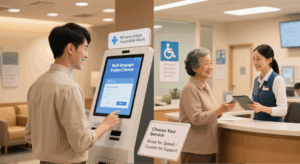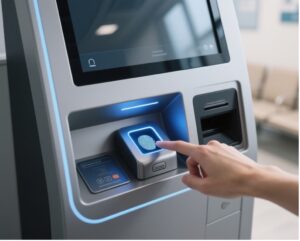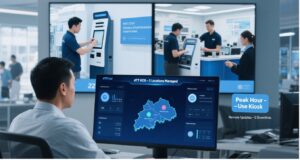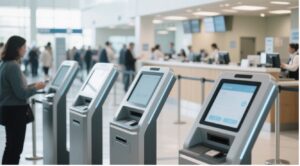
News & Updates
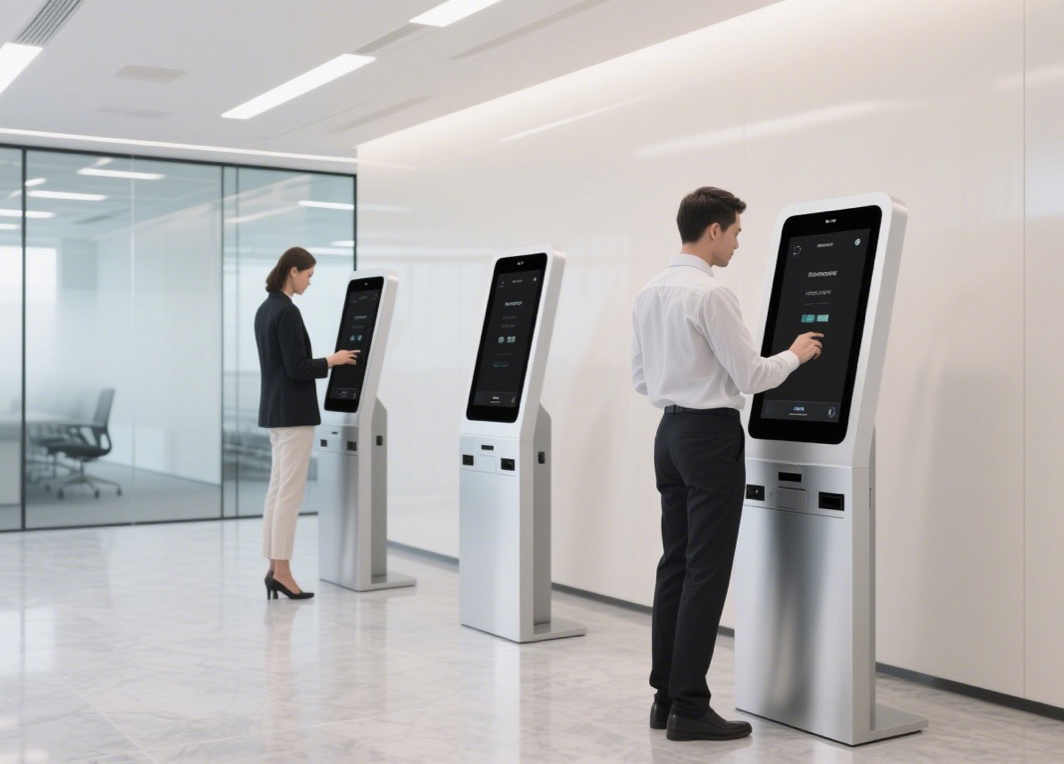
Kiosk vs. Counter Service: Which Delivers Better Enterprise Customer Experience?
Kiosk and counter service models are reshaping enterprise customer service strategies as organisations accelerate their digital transformation journeys in 2025. The decision to deploy self-service kiosks or maintain traditional counter operations is more than a matter of preference it directly impacts customer satisfaction, operational efficiency, and regulatory compliance.
Enterprises across healthcare, government, financial services, and transport are evaluating which service model best supports their goals for service excellence and resource optimisation. In this comparative analysis, we’ll explore how kiosks and counters influence throughput, personalisation, compliance, and long-term business outcomes, using real-world examples and current trends. Whether your organisation is considering modular kiosk deployment or optimising your staffed counters, understanding the strengths and limitations of each approach will help you design a service strategy that delivers measurable value and sustainable digital success.
Operational Efficiency: Automating vs. Staffing Service Points
In high-volume enterprise environments, streamlining operations is critical to maintaining service quality and managing costs. Self-service kiosks have emerged as a powerful tool for automating routine transactions, such as registrations, payments, and check-ins. By reducing dependency on staff, kiosks enable businesses to process customers rapidly and minimise manual errors, particularly during peak hours. This automation not only increases throughput but also allows personnel to focus on more complex, value-added tasks.
In contrast, counter service models rely on trained staff for direct customer interaction. While counters can address unique queries and offer a human touch, they often require higher staffing levels to maintain service speed, especially in sectors with unpredictable foot traffic. This reliance on manpower introduces variability in service delivery and can create bottlenecks, particularly when demand surges. Enterprises must weigh the operational trade-offs automation for consistency and speed versus human oversight for flexibility and problem-solving.
Kiosk Automation for Faster Throughput
Self-service kiosks are designed to handle transactions efficiently, completing processes like registration, payment, and check-in within seconds. In public sector deployments, studies in 2025 have demonstrated up to a 40% reduction in average wait times where kiosks are introduced. This swift processing helps enterprises avoid congestion during busy periods and ensures consistent service delivery. Automation not only eliminates repetitive manual tasks but also frees staff to manage exceptions or provide assistance to customers with more complex needs. ATT’s Kiosk Operation Solution (KOS) is purpose-built for such environments, offering flexible formats and seamless integration with existing enterprise systems, thereby supporting both high throughput and adaptability.
Counter Service: Human Oversight and Flexibility
Counters staffed by knowledgeable personnel offer the advantage of tailored solutions, accommodating customer requirements that fall outside standard workflows. This personalisation is especially valuable in sectors where queries may be complex or sensitive, such as banking, healthcare, or government services. However, scalability remains a challenge during periods of high demand, queues tend to lengthen, and operational costs rise due to increased staffing requirements. While counters excel in delivering empathy and expertise, maintaining consistent speed and quality across all customer interactions can be difficult.
Organisations must therefore balance the benefits of human oversight with the operational realities of resource allocation and service consistency.
Customer Experience: Personalisation vs. Convenience
Customer expectations in 2025 are shaped by sector-specific requirements and growing demand for both autonomy and personalised support. Self-service kiosks respond to the need for fast, frictionless experiences, offering digital interfaces that allow customers to complete their journeys independently. For many users particularly those comfortable with technology this convenience translates into higher satisfaction and perceived value.
On the other hand, counter service remains essential for demographics who prefer face-to-face interaction or require assistance with complex queries. Staffed counters can provide empathy, reassurance, and solutions tailored to individual circumstances, which is crucial in regulated or high-assistance environments. Organisations increasingly recognise the value of hybrid models, combining kiosks and counters to accommodate diverse user needs and enhance overall service reputation.
Instant Self-Service for Tech-Savvy Users
Kiosks are popular among customers who value speed and independence in their service interactions. Modern digital interfaces offer intuitive navigation, multi-language support, and real-time updates, making them accessible to a wide range of users.
Satisfaction rates among tech-savvy users have risen in sectors like healthcare and transport, where the ability to control one’s journey from appointment booking to payment boosts overall experience. The flexibility of platforms such as ATT’s Online Resource Booking System (ORBS) further enhances this autonomy, enabling seamless scheduling and resource allocation.
Counter Service: Empathy and Complex Query Handling
Face-to-face counters remain crucial for customers less confident with digital technology or those facing intricate service needs.
Staff are able to resolve complex queries, offer guidance, and build trust attributes especially valued in environments where personal reassurance is essential, such as banks, hospitals, and government offices. Surveys conducted in regulated sectors show that counter support is directly linked to higher satisfaction scores, particularly in scenarios requiring detailed explanations or sensitive handling. The human element ensures that no customer is left unsupported, regardless of the complexity of their request.
Hybrid Approaches for Inclusive Service
Organisations adopting hybrid service models providing both kiosk and counter options report measurable improvements in customer satisfaction and reduced complaint rates. By catering to the needs of all demographics, enterprises achieve higher Net Promoter Scores (NPS) and foster a reputation for inclusivity. This balanced approach supports accessibility, ensures no user is excluded, and enables businesses to deliver both speed and empathy. ATT’s suite of solutions, including integrated queue management and visitor systems, helps enterprises build versatile service environments that adapt to evolving user expectations.
Compliance, Security, and Data Management
Compliance and data security are paramount in enterprise service delivery, especially in sectors subject to stringent regulatory requirements. Self-service kiosks incorporate advanced security features, including encrypted payment processing and biometric authentication, to protect sensitive data and ensure audit readiness. ISO-certified platforms such as ATT’s KOS deliver comprehensive audit trails and real-time monitoring, reducing the risk of fraud and supporting regulatory compliance.
In contrast, counter service relies heavily on manual procedures for identity verification and record-keeping. While effective for low-volume environments, this approach can introduce risks as footfall increases, making it harder to maintain transparency and adhere to data protection standards. Organisations are increasingly integrating digital record systems with counter operations to enhance compliance, improve accountability, and mitigate operational risks.
Kiosk Security: Encrypted Transactions and Access Control
Modern kiosks are equipped with robust security protocols, including encrypted transaction processing, biometric authentication, and role-based access controls. These measures ensure that sensitive customer data is protected throughout every interaction. ISO-certified solutions like ATT’s KOS provide comprehensive audit trails, enabling organisations to monitor transactions in real time and respond rapidly to potential security incidents. Such features are especially important in the healthcare and public sectors, where regulatory compliance and data privacy are non-negotiable. By automating authentication and monitoring, kiosks help enterprises maintain a secure and accountable service environment.
Counter Service: Manual Oversight and Data Privacy
Counter service relies on staff to verify identities and manage records, a process that can be effective in smaller settings but becomes cumbersome as visitor volumes grow. Manual record-keeping introduces the potential for errors and makes it harder to track compliance in real time. As regulatory requirements evolve in 2025, enterprises are advised to integrate digital systems with counter operations, supporting transparency and simplifying audit processes. By combining procedural controls with automated record management, organisations can better safeguard sensitive data and meet sector-specific compliance standards.
Scalability and Adaptability: Meeting Enterprise Growth
As businesses expand, service models must adapt rapidly to increased demand and evolving operational needs. Self-service kiosks are designed for modular deployment, allowing enterprises to roll out new service points across multiple locations with minimal disruption. Cloud-enabled management further streamlines updates and configuration, enabling organisations to respond swiftly to market changes and operational requirements.
Scaling counter service, by contrast, involves recruiting, onboarding, and training additional staff a process that is both time- consuming and resource-intensive. Ensuring consistency in service quality across all branches introduces further management challenges. Enterprises must consider the long-term implications of their chosen model, balancing the flexibility and scalability offered by kiosks with the human expertise provided by counters.
Kiosk Deployment Across Multiple Locations
Self-service kiosks can be deployed across branches quickly, thanks to cloud-based central management and remote configuration capabilities. Enterprises benefit from minimal downtime during installation and can implement updates or new features rapidly in response to changing business needs. This agility is particularly valuable for organisations with multi-site operations, such as healthcare networks or government agencies. ATT’s KOS solution supports centralised administration, ensuring consistent service standards and facilitating future growth without major infrastructure investment.
Counter Service: Staff Training and Management Challenges
Scaling up counter operations requires a significant investment in recruitment, onboarding, and ongoing training. Service quality depends heavily on staff performance, which can vary between locations and over time. Maintaining consistency and meeting compliance standards becomes increasingly challenging as the workforce grows. Management overheads rise, and operational complexity can impact overall efficiency. Enterprises must therefore assess whether their expansion strategy is best served by increasing staff or investing in scalable digital solutions.
Integrating Kiosks with Existing IT Ecosystems
Modern kiosks connect seamlessly with enterprise IT systems, including queue management (EQMS), visitor management (VMS), and payment platforms. This integration enables automated workflows and centralised monitoring, reducing manual intervention and supporting operational transparency. ATT’s portfolio of solutions is designed for interoperability, allowing organisations to future-proof their service infrastructure and streamline digital transformation. By lowering barriers to integration, enterprises can scale efficiently and adapt to emerging business requirements without disruptive change.
Cost Analysis: Investment vs. Outcomes
Financial considerations are central to the decision between kiosks and counter service. Self-service kiosks typically involve higher upfront investment in hardware and software, but deliver long-term savings through reduced staffing requirements, lower error rates, and increased transaction volumes. Enterprises often see a return on investment within 18 to 36 months, with annual operating costs reduced by up to 30% in high-volume environments.
Counter service, while requiring less initial outlay for technology, incurs ongoing expenses for salaries, benefits, and training. Budget predictability is lower, and scaling operations during peak periods can strain resources. Organisations must carefully evaluate the total cost of ownership for each model, considering both direct and indirect costs alongside projected business outcomes.
Total Cost of Ownership for Self-Service Kiosks
Kiosk solutions are designed to deliver measurable cost savings over time. By automating routine transactions and reducing reliance on staff, enterprises can lower operational expenses and improve accuracy. In 2025, businesses deploying self-service kiosks report investment recovery within 18 to 36 months, driven by gains in productivity and reduced error rates. Annual operating costs often decrease by up to 30%, making kiosks a compelling choice for sectors with high transaction volumes. The scalability and efficiency of platforms like ATT’s KOS further enhance ROI, supporting sustained growth and streamlined operations.
Counter Service: Ongoing Personnel and Training Costs
Staffed counters incur recurring costs for salaries, benefits, and continuous training. While the initial technology investment may be lower, these expenses accumulate over time, affecting overall profitability. Scaling up during peak periods can stretch resources and introduce variability in service quality, impacting customer satisfaction and ROI. Enterprises must factor in these hidden costs when assessing the long-term viability of counter service as their primary model for customer engagement.
Choosing the Right Service Model for Enterprise Success
Kiosk and counter service models each offer unique benefits and challenges for enterprise customer service. The optimal choice depends on your sector, customer demographics, and business objectives. By evaluating operational efficiency, customer experience, compliance, scalability, and cost, organisations can design a service strategy that balances automation with the human touch driving both operational excellence and lasting customer satisfaction. If you’re considering how ATT’s integrated solutions can advance your transformation, our team is ready to provide a tailored consultation for your next step in digital service delivery.
Frequently Asked Questions (FAQ)
How does kiosk service reduce wait times?
Kiosks streamline processes by enabling self-service options for tasks like check-ins, payments, and registrations. This reduces the dependency on staff, allowing faster service for routine transactions and minimizing overall wait times for customers.
What are the benefits of combining kiosks and counter services?
A hybrid approach allows businesses to cater to diverse customer preferences. Kiosks handle routine tasks efficiently, while counters provide personalized service for complex or sensitive needs. This combination improves customer satisfaction and optimizes operational efficiency.
Are kiosks accessible for users with disabilities?
Yes, modern kiosks are designed to be accessible, incorporating features like touchscreens with adjustable height, voice assistance, and braille keypads. These enhancements ensure usability for customers with varying abilities, promoting inclusivity.
How do kiosks enhance data accuracy?
Kiosks reduce errors by automating data entry processes and guiding users through predefined workflows. This minimizes manual intervention and ensures consistency, improving the overall accuracy of collected information.
What role does counter service play in building customer trust?
Counter service provides a human touch, allowing staff to address customer concerns with empathy and personalized attention. This builds trust and creates a positive customer experience, especially in scenarios where reassurance is essential.
Can kiosks be customized for specific industries?
Yes, kiosks can be customized with software and hardware tailored to industry needs. For instance, healthcare kiosks may include patient check-in features, while retail kiosks can handle inventory lookup and self-checkout functionality.
How do kiosks contribute to sustainability efforts?
Kiosks reduce paper usage by digitizing processes such as ticketing, forms, and receipts. They also lower energy consumption by replacing traditional counter setups that require more resources for operation, contributing to a more sustainable business model.
What training is needed for staff when integrating kiosks?
Staff training focuses on assisting customers with kiosk usage, troubleshooting basic issues, and understanding how kiosks integrate with backend systems. This ensures a seamless transition for both employees and customers.
Do kiosks support multilingual interfaces?
Yes, kiosks often support multiple languages, allowing users to select their preferred language for interaction. This feature makes kiosks accessible to diverse audiences and improves the overall user experience.
What metrics can kiosks track to improve business operations?
Kiosks can track metrics such as transaction volumes, average service times, user preferences, and peak usage hours. These insights help businesses optimize operations, improve customer service, and make data-driven decisions for future strategies.
Send us a message
Contact Information
Address:
35 Ubi Crescent, ATT Building, Singapore, 408585
Phone:
Email:
Website:
www.attsystemsgroup.com



